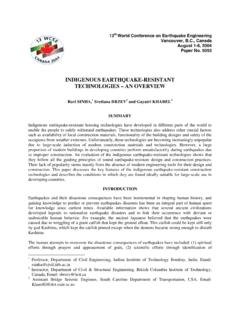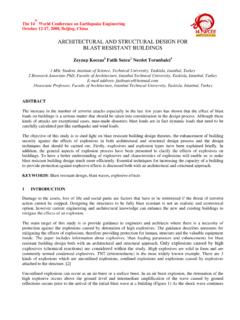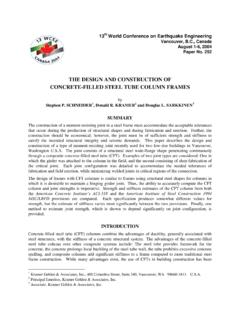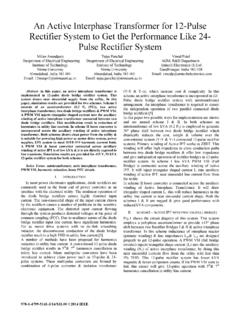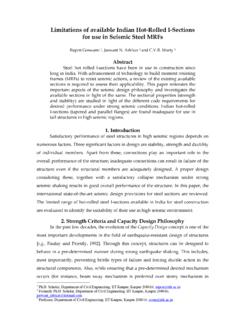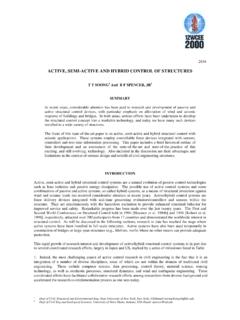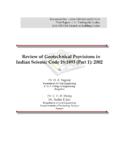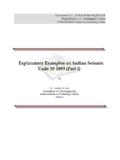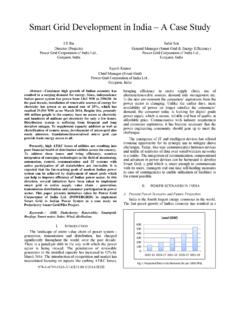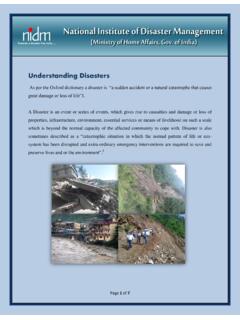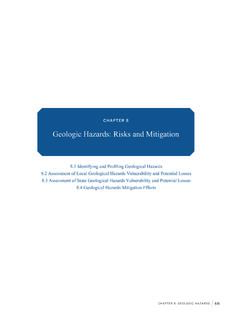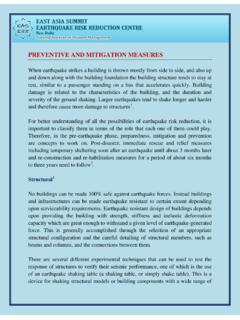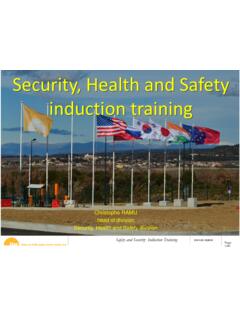Transcription of Structural Health Monitoring - IIT Kanpur
1 Structural Health MonitoringD ProfessorIIT PatnaD ProfessorIIT KanpurWorkshop on earthquake RESISTANCE OF LOW-COST ENGINEERED HOUSING IN NORTH-EAST INDIA 24-25 June 2016, IIT Guwahati What is Structural Health Monitoring (SHM) The process of implementing a damage detection and characterization strategy for engineering structures SHM Involves: Healthmonitoring Operational Evaluation Data FeatureExtraction StatisticalModels Development2 Objective of Structural Health Monitoring Performanceenhancementofanexistingstruct ure Monitoringofstructuresaffectedbyexternal factors Feedbacklooptoimprovefuturedesignbasedon experience Assessmentofpost-earthquakestructuralint egrity Declineinconstructionandgrowthinmaintena nceneeds Themovetowardsperformance-baseddesignphi losophy3 Determination of damage existenceDetermination of damage s geometric locationQuantification of damage severityPrediction of remaining life of the structureSteps of Structural Health Monitoring4 Success of ongoing Health Monitoring520052013 Estimated Investment trillion(by 2010) trillion(by 2020)
2 Overall ConditionDD+Infrastructure20052013 AviationD+D BridgeCC+DamsDDDrinking WaterD-DEnergyDD+Hazardous WasteDDInland WaterwaysD-D-PortsC-CPublicParks and RecreationCC-RailC-C+RoadsDDSchoolsDDSol id WasteC+B-TransitD+DWaste WaterD-D[ #p/grade-sheet/gpa]GradeImplication AExceptional (fit for the future)BGood(adequate for now)CMediocre(requires attention)DPoor(at risk)EFailing(unfit for purpose)Need for Structural System IdentificationCourtesy: Google Image6 Worldwide Monitoring Projects7 How to Do SHM inpractice? VisualInspection Fully experience-based Subjective/Non-quantitative Non-Destructive Evaluation(NDE) Varioustechnologies for differentpurposes Demands a highdegree ofexpertise Timeconsuming andcostly Usually requires a priori knowledge of the potentiallydamaged region Works only in accessibleregionsof thestructure Interruption and downtime Labourintensive and risky8 Current Practice : Visual Inspection 9vibration-based methods are gaining popularities in Structural Health Monitoring and damage detectionNDTV isual InspectionMagnetic Particle TestingDye Penetration TestRadiography Test10 Eddy Current TestUltrasonic TestNDTA coustic Emission TestThermal Infrared Test11 How to Do SHM inpractice?
3 Static-BasedSHM Based on the premise that damage will alter thestaticproperties of thestructure. displacements, rotations DrawbackConsiderable static deflection requires large amount of static force12 How to Do SHM inpractice?Vibration-BasedSHM Based on the premise that damage will alter thedynamicproperties of thestructure. Structural response, frequencies, modeshapes, damping or modal strain energy change By measuring the Structural response bymeansof sensorsstrategicallyplacedon the structure, and intelligently analyzing these measured responses, it is possible to identify damageoccurrence. It can be done either in modal domain or physical domain13 Vibration Based SHM:Sensors Different forms of dynamic structuralresponse: Displacement, Velocity, Acceleration,Strain. Which ones to measure depends on Monitoring conditionsand objectives.
4 Sensing technology: an ever emerging field ofstudy Based on what to measure, different sensorsavailable: Laser Displacement Sensors(LDS) VelocityTransducers Seismometers PiezoelectricAccelerometers StrainGauges Most of these sensors can be wirelesslyconnected14 Accelerometer (Acceleration)Load Cell (Force)LVDT (Displacement)Strain Gauge (Strain)Collection of Sensory Information15 Vibration Based SHM:SensorsPros and cons of various types ofsensors: Bandwidth: displacement sensors capture lowfrequencymodes acceleration sensors capture high frequency modes Global : strain gauges capture local dynamicsbetter accelerometers/displacement sensorsmeasureglobaldynamics16 Vibration Based SHM: Model-BasedTechniques* Based on a model ( ) of the monitoredstructure.*Optimization basedmethods: An initial model is updated using measured Structural FE modelupdating Optimization algorithms are run by iteratively changing the valuesof some Structural properties ( Young s modulus), so that the FEM parameters match measuredparameters.
5 Measured parameters: Measured responses or someparametersobtained from measured responses ( modalproperties). Usually require repeatedly solving the Based SHM: Model-BasedTechniquesAlternatively, inverse problem solutionapproach: Identify modal parameters using some system identification method. Use identified modal parameters to obtain physical parameter (mass, damping, stiffness) matrices. Does not require repeatedly solving the forward problem, but is Based SHM: Model-BasedTechniques PROS: Allow damage detection, as well as damage location and extent estimation. May even be used to assess the damage type and to estimate the structure s remaining life, though research is still at its onset in thisregard CONS: Require high userexpertise Affected by modelling assumptions ( boundary conditions, number of DOFs, material properties,etc.)
6 Often too manyunknowns Usually computationallyexpensive19 Vibration Based SHM: Data-BasedTechniquesData-Basedtechniques arebasedonstatistical, ratherthanphysicalmodelsofthestructure. Thesemethodsarecalleddata-basedbecauseth efeaturesextractedfromthestructuralrespo nseareobtainedbysimpleoperationsperforme dontheresponsetimehistoriesitself,anddon otrequireanyphysicalmodelassumptions. Theseapproachesareoftensaidto letthedataspeakbythemselves .20 Vibration BasedSHM: Data-BasedTechniquesPROS Do not require high userexpertise. Often coined using machine learning knowledge:highlycomputationally efficient and ideal to beautomated. Take into account uncertainties inherently present inSHM. Free from modeling assumption Without a physical model, can at most reach the second level of the damage detection hierarchy (damagelocation).
7 Being based on a statistical model of the features, they require sufficient data to Based SHM:UncertaintiesMany sources of uncertainty in the different stages ofSHM:During dataacquisition: Measurementnoise, Environmental effects (different temperature, humiditylevels), Unknown and nonstationary inputs (traffic, wind, earthquake ;may excite different frequencyregions), Missing data (not every point on the structureobserved).During featureextraction/modeling/identificatio n: Modelingassumptions, Errors associated with any numericalmethod, Non-unique identification (many models may fit the measured data equallywell).22 Courtesy of Prof. E. Chatzi,ETHSHM by Structural System Identification23 Infrastructure is expected to provide: reliable service for long periods of time, Undergoing major technology changes, spanning several generations and experiencing dramatic evolutions Develop Wireless Sensor Networks Reliable Energy aware SmartStructural Monitoring Challenges24 Some Barriers in SHM up today Conventional cables High installation costs Vulnerableto ambient signal noisecorruption Vulnerable to earthquake conditions Size and complexity of large structures require a large number of sensing points to be MetricsMeasure.
8 Acceleration Strain Climatic Conditions Curvature Displacements Load Tilt/Slope ScourIdentify Corrosion Cracking Strength Tension Location of rebar/delaminations26 Smart Sensor conceptEarthquake Event Sensors Wake-up (unique IDs)Events Recorded and stored in BSSensors go back to sleep27 Future of SHM28 Study-1: G+8 storeyRCC BSNL building in Guwahati (Borsaikia, Dutta, Deb 2011) 1stEarthquake (11thFeb,2006) Depth 33 Km in Arunachal Pradesh-Tibet Border. 2ndEarthquake (12thAug,2006) Depth 66 Km in India-Bangladesh : G+8 storeyRCC BSNL building in Guwahati (Borsaikia, Dutta, Deb 2011) damage has been localized using Parametric State Space Modeling. Stiffness of Each storeyshas been triaxialforce balance in ground and top floor, 4 uniaxial accelerometers in 1st, 3rd, 7thand top in shorter direction and 3 uniaxial accelerometers in 1st, 5thand top of longer direction.
9 30 Study-2: MilikanLibrary, CalTech(Clinton et al 2006)The current (2006) forced vibration fundamental frequency of east westis 22% and of north-south is 12% lower than that originally measured in 1968 forced vibrations using varying forces. minor earthquake shaking. weather conditions (rain and wind events, extremes in temperature)Plan dimension is 21m and height from basement is are densely mounted on the building and these are continuously monitored31 Study-3: Long Beach Public Safety building (LBPSB), California (Chassiakoset al 2006) Six storey rectangular steel building built in 1950s, having plan dimension of Due to 1994 Northridge earthquake this facility need significant seismic mitigation measures. So Health of this structure was monitored and it was retrofitted. The ambient vibration data collected before, during, and after the Structural RetrofitFreqafter Retrofit% % : Long Beach Public Safety building (LBPSB), California (Chassiakoset al 2006)Finite element model of pre-retrofit Long Beach Public Safety BuildingFinite element model of post -retrofit Long Beach Public Safety of SHM in Housing for All Project North-East India is prone to earthquake hazards So Monitoring is important to reduce seismic hazard Proposed Idea.
10 One house will be properly instrumented among a colony of houses Sensor data will be taken once in a year and the Health of that colony can be estimated Visual inspection and NDTs will be done in a regular basis This will also be used for post - earthquake Health assessment and validate retrofitting operations34 FibreOpticsLaser VibrometerUltrasonic SensorSensor Technology36 Structural Monitoring Challenges Develop Design-to-service Solutions Efficient Monitoring Digital Signal Processing strategies Evaluation Criteria Knowledge bases Develop Smart Control Units Real-time Feedback Centralized (or not)37 Technological Solutions Wireless Sensors Accelerometers/Inclinometers etc Laser Scanning RFIDs (Radio Frequency Identification) Acoustic Emissions MEMS (Micro-Electro-Mechanical Systems) Increase of Computation capabilities Fiber technologies38
